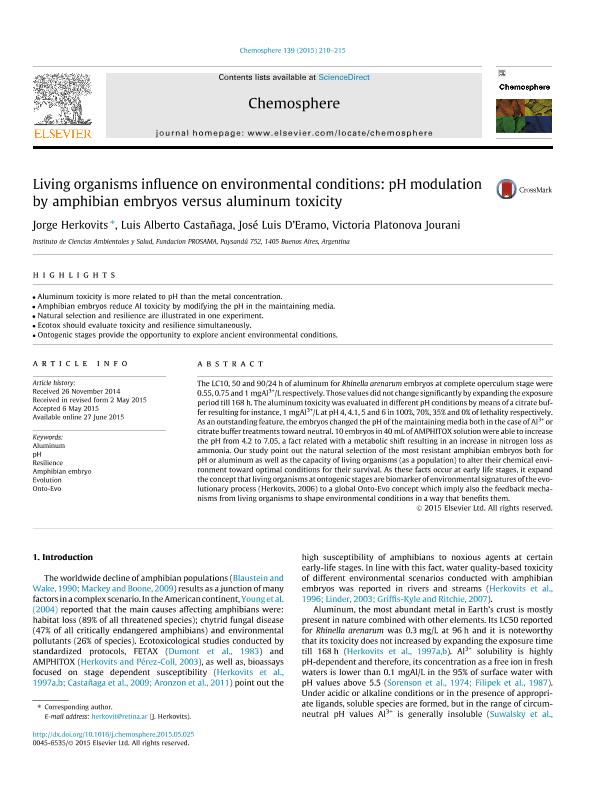Artículo
Living organisms influence on environmental conditions: pH modulation by amphibian embryos versus aluminum toxicity
Fecha de publicación:
06/2015
Editorial:
Pergamon-Elsevier Science Ltd
Revista:
Chemosphere
ISSN:
0045-6535
Idioma:
Inglés
Tipo de recurso:
Artículo publicado
Clasificación temática:
Resumen
The LC10, 50 and 90/24 h of aluminum for Rhinella arenarum embryos at complete operculum stage were 0.55, 0.75 and 1 mgAl3+/L respectively. Those values did not change significantly by expanding the exposure period till 168 h. The aluminum toxicity was evaluated in different pH conditions by means of a citrate buffer resulting for instance, 1 mgAl3+/L at pH 4, 4.1, 5 and 6 in 100%, 70%, 35% and 0% of lethality respectively. As an outstanding feature, the embryos changed the pH of the maintaining media both in the case of Al3+ or citrate buffer treatments toward neutral. 10 embryos in 40 mL of AMPHITOX solution were able to increase the pH from 4.2 to 7.05, a fact related with a metabolic shift resulting in an increase in nitrogen loss as ammonia. Our study point out the natural selection of the most resistant amphibian embryos both for pH or aluminum as well as the capacity of living organisms (as a population) to alter their chemical environment toward optimal conditions for their survival. As these facts occur at early life stages, it expand the concept that living organisms at ontogenic stages are biomarker of environmental signatures of the evolutionary process (Herkovits, 2006) to a global Onto-Evo concept which imply also the feedback mechanisms from living organisms to shape environmental conditions in a way that benefits them.
Palabras clave:
Aluminium
,
Resilience
,
Environmental
,
Amphibian
,
Ph
,
Oxygen Consumption
Archivos asociados
Licencia
Identificadores
Colecciones
Articulos(SEDE CENTRAL)
Articulos de SEDE CENTRAL
Articulos de SEDE CENTRAL
Citación
Herkovits, Jorge; D'eramo, Jose Luis; Castañaga, Luis Alfredo; Platonova Jourani, Victoria; Living organisms influence on environmental conditions: pH modulation by amphibian embryos versus aluminum toxicity; Pergamon-Elsevier Science Ltd; Chemosphere; 139; 6-2015; 210-215
Compartir
Altmétricas




